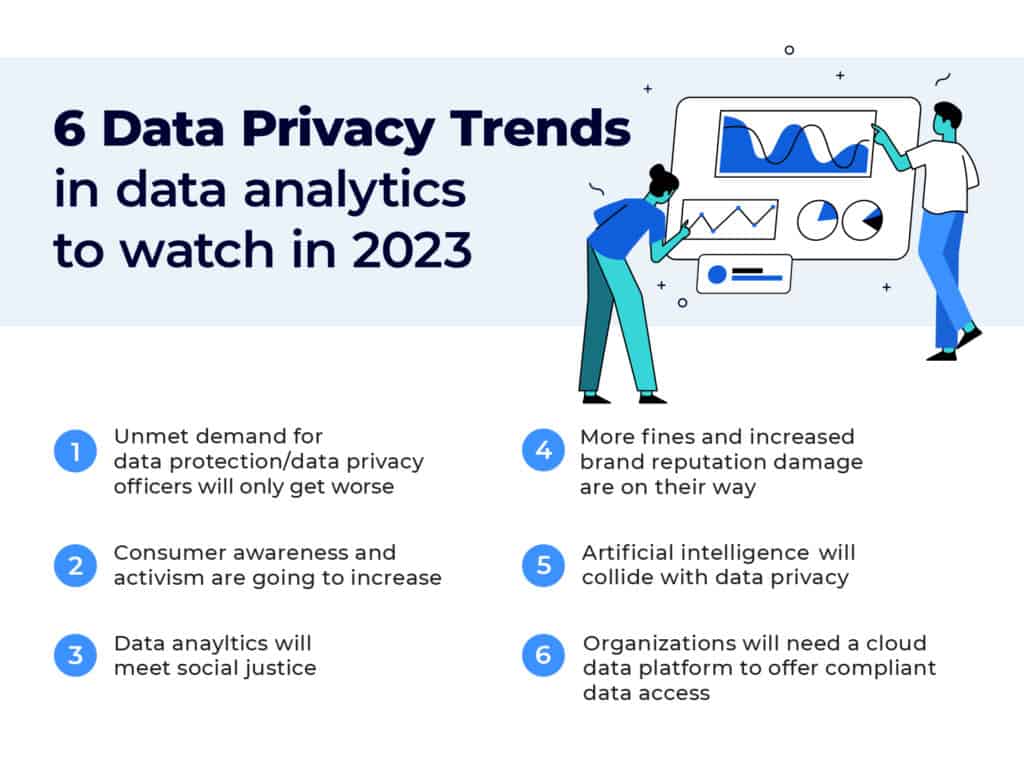Six Data Privacy Trends in Data Analytics to Watch in 2023
Teresa Wingfield
January 3, 2023

Just like climate change, data privacy is a topic that’s grown from warm to hot and is moving into an extreme heat wave. This fast-moving issue inspired me to get out my crystal ball to predict top trends for 2023. Here are six data privacy trends, that lie ahead next year in the world of data analytics.

1. Unmet Demand for Data Protection/Data Privacy Officers Will Only Get Worse
For many businesses, it’s no longer sufficient for someone in their legal, finance or IT teams to take on the data privacy challenge as an added responsibility. Understanding and monitoring compliance with the deluge of new privacy laws and keeping up with relevant data and analytics trends is a full-time job. Plus, the data protection officer is a mandatory role for all companies that collect or process EU citizens’ personal data, under Article 37 of the General Data Protection Regulation (GDPR) if:
- A public authority or body conducts processing.
- Core activities of the controller or the processor consist of processing operations which require regular and systematic monitoring of data subjects on a large scale; or
- Core activities of the controller or the processor consist of processing on a large scale of special categories of data or personal data relating to criminal convictions and offences.
2. Consumer Awareness and Activism Are Going to Increase
Consumers are already concerned about the way companies are using their data. The Cisco 2021 Consumer Privacy Survey found that 32% of consumers have terminated relationships with online and traditional companies over data privacy concerns. At the same time, consumer awareness of privacy and data protection rules is low. DataProtect reports that just 3% of Americans say they understand how the current laws regulating online privacy in America work.
Don’t expect low awareness to continue as consumers read more about data and analytics trends such as new compliance laws and reported violations. At the least, data privacy advocacy groups will increase their watchdog activities on behalf of consumers.
3. Data Analytics Will Meet Social Justice
Over the last few years, awareness of systemic injustices in our society has also increased, and this includes knowledge of how advanced analytics can result in inequitable outcomes. For example, a bank may deny a person of color a mortgage, even if the credit rating and financial profile are the same as someone the bank accepted for a mortgage for a similar property. Businesses will need to take greater care when aggregating data and modeling analytics to ensure there isn’t systematic bias against a demographic. Otherwise, the organization can be held liable.
4. More Fines and Increased Brand Reputation Damage Are on Their Way
Fines for compliance violations are already increasing, with GDPR fines skyrocketing by 600% to €1.1 billion in 2021. Alongside increased consumer awareness and activism, it’s only natural that more fines will follow.
Also, keep in mind that data privacy is a brand reputation issue, not just a compliance issue. It’s going to become even harder for companies to bounce back and repair the damage to their brand as consumers become more aware of a business’ legal obligations to protect their privacy.
5. Artificial Intelligence (AI) Will Collide with Data Privacy
AI drives sensitive data analytics in search algorithms, recommendation engines, AdTech networks, and more. Just because compliance regulations don’t explicitly mention AI, it doesn’t mean that compliance provisions aren’t relevant to AI. For this reason, I’m predicting a greater need to consider data privacy in AI design including building, training and deploying machine learning models.
6. Organizations Will Need a Cloud Data Platform to Offer Compliant Data Access
I would like to end with what I envision as a greater requirement for cloud data platform adoption for data analytics. The right solution can help break down data silos that introduce greater non-compliance risks since you don’t have full visibility. The right solution can help drive equitable outcomes and ensure that users only see the data they should. A cloud data platform can also help configure data quality rules to ensure data is accurate, consistent, and complete, as more laws require that organizations clean up their bad data. For example, Article 16 of the GDPR requires companies to rectify inaccurate personal information and complete missing personal data without undue delay.
Additional Resources:
Subscribe to the Actian Blog
Subscribe to Actian’s blog to get data insights delivered right to you.
- Stay in the know – Get the latest in data analytics pushed directly to your inbox.
- Never miss a post – You’ll receive automatic email updates to let you know when new posts are live.
- It’s all up to you – Change your delivery preferences to suit your needs.